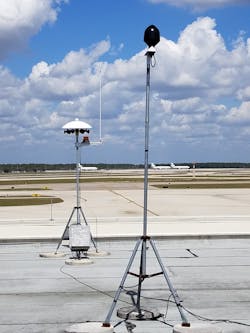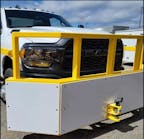Lightning poses a serious threat to ground service personnel when they are working outside.
In an incident strikingly caught on camera last July, a NavStar Global Aviation employee was seriously injured when the plane he was servicing was hit by lightning at the Southwest Florida Regional Airport (RSW) in Ft. Myers, Fla. Although not directly hit, he suffered serious injuries including third-degree burns but has since recovered.
Thunderstorms are amazingly common. Every one of the 50 states experiences thunderstorms, including Alaska, which gets numerous storms in the summer. More than 100,000 storms occur annually. There are few places on the planet that are immune, and these are basically limited to extreme Arctic areas.
Across the globe, it is estimated that 16 million thunderstorms occur each year with 2,000 storms in progress at any given moment. Some tropical locations can have over 200 storms a year.
Although thunderstorms are most common in the warm season, they can occur year ‘round, even in northern locales (the infamous “thundersnow”). Thunderstorms are most frequent in the afternoon and early evening, but again can occur any time of the day.
For airport managers who are concerned with the thunderstorm threat, the first step would be to check the weather forecast. Meteorologists will determine if conditions are favorable for thunderstorms to occur.
Storms can either more into an area or just develop in the region. Storms that are moving in are typically associated with pronounced weather systems like cold fronts or low pressure areas. These are somewhat easier to forecast. Storms that just develop (called “air mass thunderstorms”) are more difficult to predict accurately. In fact, it is impossible to know exactly when and where a storm will form.
Fortunately, the technology of lightning detection has come a long way since the days when people simply looked at the skies and listened for thunder. It was during World War II that radar operators discovered they could see areas of rain on their radar screen as well as aircraft. After the war ended, military radars were converted to civilian use. By the 1950’s, weather radars were being widely used.
Actually, radar does not detect electrical activity. The microwaves sent out by the radar transmitter are reflected back by precipitation-size droplets or ice crystals. This is what’s seen on a radar display.
The amount of energy returned, and therefore the strength of the “echo,” is a function of particle size and precipitation intensity.
This is color coded for easier interpretation. Thunderstorms tend to have larger droplets and heavy rainfall rates. They will show up as yellow and, especially, red on a radar screen. It can be inferred from the intensity of rainfall that this is a cloud capable of producing electrical activity. By looking at a radar display, people can not only tell where thunderstorms are currently occurring, but by watching over time, they can determine the direction and speed of movement.
To actually know if lightning is occurring, a lightning detector is needed. A lightning bolt emits a variety of electromagnetic waves. With the proper receiving equipment, it can be detected.
Over the years, such receivers have been developed and refined. With a network of lightning detectors, someone can determine the exact time and location of strikes, display the data, and use it for warning purposes.
There are a number of private companies that offer lightning detection services designed for airports. Airport personnel can determine the warning criteria, i.e. how far away a lightning bolt hitting the ground will then trigger a warning at the airport.
But even lightning detectors can only tell where lightning has occurred, not where it will strike next. Complicating the problem is the fact that lightning can strike far from the parent thunderstorm. The famed “bolt-from-the-blue” is often a lightning bolt from the top, not the base, of the storm. These “positive giants,” as they are officially called, can strike a number of miles from the storm itself.
These concerns lead to the latest development in lightning warning systems – lightning prediction.
Lightning is an electrical discharge in the atmosphere. With thunderstorms, the electrical potential builds up due to the fact that air is a poor conductor of electricity. The base of the cloud is negatively charged and the ground below is relatively positive. At some point, the potential becomes too great and an electrical pathway, the lightning bolt, occurs. Electrical charges flow both up and down and multiple discharges can occur (this is the flickering effect seen with some bolts).
Sensors have been developed that can measure the electrical potential at a location. A person can see when the potential is building quickly to a danger point. Using this information, he or she can anticipate a lightning strike and send out a warning.
The lightning risk is so great for airport ground crews that they are included in the list of outdoor workers for whom lightning safety is a major concern, according to the Occupational Safety and Health Administration (OSHA).
Employers are required to have an Emergency Action Plan (EAP) dealing with lightning situations. The EAP should clearly state that lightning is a hazard which requires action, specify how workers are alerted to the lightning threat, and identify safe areas where workers should go in a timely manner. All employees should receive training on lightning safety and on the specific EAP.
So what is actually done at airports to protect ground crews?
“Tampa International Airport has a Precision Lightning Warning System in place with red lights and horns (audible and visual) that go off when a lightning strike is detected within 3.2 miles. All airfield personnel, whether airline, construction or airport employees, have their own procedures for seeking shelter depending on location, but typically ramp workers would seek shelter in the terminals, maintenance workers would seek shelter in the maintenance hangar, etc.,” explains Emily Nipps, senior manager of communications at Tampa International Airport. “Once lightning has not been detected within that area for five minutes, a yellow light signals the workers can return to the airfield/tarmac. A lot of airlines will wait an additional five or more minutes beyond that as an even greater precaution. It is not a federally mandated system, but many commercial airports use similar guidelines for weather safety.”
Southwest Florida International Airport, where the above mentioned incident occurred, is located in the most thunderstorm-active region in the United States. The Fort Myers area averages 90 days with thunderstorms a year. Satellite lightning detectors indicate up to 200 flashes of lightning per square mile per year.
Speaking to the News-Press shortly after the lightning incident, Vicki Moreland, department director-communications and marketing for the Lee County Port Authority, which runs the RSW airport, said their system from Thorguard has two components. If lightning is detected or predicted within five miles, a warning strobe-light outside the concourse area is set off. The light can be seen anywhere on the field. If lightning is predicted or detected within one mile of the airport, a second, stronger warning activates a radio alert initiating immediate reaction. Lee County Port Authority workers are under orders to take cover.
The system was active when the ground worker was struck.
However, she points out that all parties, including ground support personnel, have their own polices concerning lightning on the field. Moreland added that Lee County Port Authority takes employee safety seriously, and the organization urges anyone in an unprotected area to seek shelter when Thorguard activates.
Although individuals inside a significant building are reasonably safe from lightning, to further protect the people inside and the building itself, a lightning protection system (LPS) can be installed.
Based on Benjamin Franklin’s idea for a lightning rod, today’s LPS utilizes small rods known as “air terminals” on the roof. These will intercept any lightning bolt that was destined to strike the building. The electrical charge is then transmitted harmlessly to the ground via wires or cables. This will keep the building and its occupants safe.
And what about the future? A lightning strike forecast an hour ahead of time? It’s in the works. In fact, meteorologists are working on a computer model which could do just that.
By looking at the current state of the storm, detailed weather conditions surrounding the storm, and comparison to past storms, a forecast of lightning strikes up to one hour out is possible. Kristin Calhoun, lead project scientist on the model and alert system (and former student of mine), was engaged in thunderstorm research when “it clicked with me that we could actually use these techniques to predict lightning.”
After some modifications and testing, she says the model could be ready for emergency managers by two years with a more general public version a few years later.
Another factor, although secondary, is also a consideration. Airline services run on what is typically a tight schedule. Departures and arrivals have set times. Any delay for any reason will affect those schedules. Delays for lightning are included in this.
The problem magnifies if there is a prolonged delay or multiple delays. There can be notable air traffic impacts both at the terminal directly affected and those interconnected by flights to and from there. Although the initiation of a lightning stoppage and its length should be determined solely on the safety of personnel based on the science of lightning warnings, economic concerns are a reality of the airline business.






